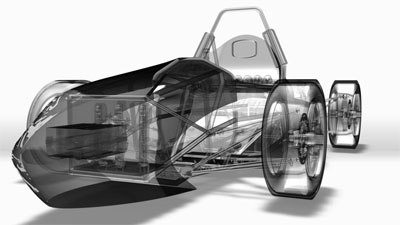
 Design and manufacturing of a single-seat formula SAE racing car
Design and manufacturing of a single-seat formula SAE racing car
Giovanni Meneghetti
University of Padua – ITALY
Curriculum
Giovanni Meneghetti was born in Treviso (Italy) on November 14th, 1969 and got his Degree in Mechanical Engineering in 1994. From 1995 until 1998 he attended a three-year PhD course in Machine Design at the University of Padova. Assistant Professor at the Department of Mechanical Engineering of the University of Padova from 2002 until 2010. Associate Professor in Machine Design at the Department of Industrial Engineering of the University of Padova from December 2010. Author of about 130 scientific publications, 40 of which published in International Journals with impact factor. His research fields deal with the development of local approaches for fatigue analysis of welded components and structures, fatigue design of structures in metallic materials, experimental analysis of strains, in-field load data acquisition and fatigue behavior of bonded joints in composite materials.
Stefano Giacometti
OZ Racing – ITALY
Curriculum
Stefano Giacometti was born in Bassano del Grappa (Italy) on August 18th,1956. He has been employed in OZ Wheels Spa (Vicenza-Italy) since 1974 and he presently is with the R&D Department. He has been cooperating with the department of Industrial Engineering of the University of Padova (Italy) since 2005 for the manufacturing, installation and development of jet-engines and wind turbines and since 2006 as manufacturing supervisor of the Formula SAE car of the students’ RaceUP racing team. In 2012 he cooperated with the DTU University (Denmark) for the manufacturing and installation of wind turbines for research purposes. From 2007 until 2010 he cooperated with the Research Center for Aerospace Studies of the University of Padova in the activity of set-up and testing of hybrid propulsion systems. He is co-author of two papers published in International Journals and supervisor of about twenty master thesis.
Abstract
The Formula SAE is an international automotive competition for university students. The challenge that each team faces is to conceive, design, manufacture and drive on the racetrack a single-seated formula style race car. To determine the winner, a jury of experts coming from the automotive and supplier industries judge every design, cost planning and business plan in comparison to the other competing teams; furthermore, the students drive their self-built car on the racetrack in a number of so-called dynamic disciplines. What the competition aims at, is to educate students to succeed in a project where the winning team is not simply the one having the fastest car, but the one offering the best overall package of design, dynamic performances and cost management of the car. In view of this, the teams have to assume that they develop a race car prototype which will be evaluated by the judges for series production. The target customers are non-professional weekend racers, for whom the car must combine very good driving performances and at the same time must be offered at a reasonable price. Then, the competition consists of an examination of each team in a number of static as well as dynamic disciplines. Static events comprise the following presentations: engineering design, cost analysis, business plan. Dynamic events comprise the following disciplines in the race track: endurance, autocross, acceleration and skid pad. The University of Padova has entered its 7th year in the formula SAE competition. The current single-seated car has a 25CrMo4 welded steel space frame while the bodywork is completely made of carbon fibre composite. The suspension system consists of double steel A-arms with pull-rod actuated longitudinal spring/damper and aluminium uprights. The brake system consists of four 220-mm-diameter floating disks with Brembo calipers. Wheels are OZ Racing 13” made of magnesium alloy. The engine is a modified four-cylinder Honda CBR 600 RR assisted by a Motec M400 electronic unit. The drive train comprises a Drexler limited slip differential, carried by aluminium alloy supports, and titanium half shafts. Driving is assisted by traction control, launch control and a pneumatic gear shift.


